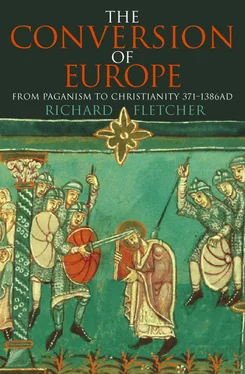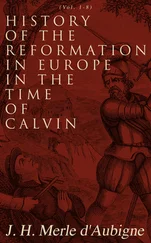In a village named Levroux [between Tours and Bourges], however, when he wished to demolish in the same way a temple which had been made very rich by its superstitious cult, he met with resistance from a crowd of pagans and was driven off with some injuries to himself. He withdrew, therefore, to a place in the neighbourhood where for three days in sackcloth and ashes, continuously fasting and praying, he besought Our Lord that the temple which human hands had failed to demolish might be destroyed by divine power.
Then suddenly two angels stood before him, looking like heavenly warriors, with spears and shields. They said that the Lord had sent them to rout the rustic host and give Martin protection, so that no one should hinder the destruction of the temple. He was to go back, therefore, and carry out faithfully the work he had undertaken. So he returned to the village and, while crowds of pagans watched in silence, the heathen sanctuary was razed to its foundations and all its altars and images reduced to powder.
The sight convinced the rustics that it was by divine decree that they had been stupefied and overcome with dread, so as to offer no resistance to the bishop; and nearly all of them made profession of faith in the Lord Jesus, proclaiming with shouts before all that Martin’s God should be worshipped and the idols ignored, which could neither save themselves nor anyone else.
There are several points of interest for us in the Levroux story. First, it is notable that Sulpicius admits the – unsurprising – fact that Martin met with resistance. Direct action was risky. In the year of Martin’s death three clerics who tried to disrupt pagan ceremonies in the diocese of Trent in the eastern Alps were killed. Their bishop, Vigilius, to whose letter to John Chrysostom describing the martyrdom we are indebted for knowledge of it, was himself stoned to death by furious pagans a few years later. When the Christian community of Sufetana in the African province of Byzacena demolished a statue of Hercules a pagan mob killed sixty Christians in reprisal. Second, one cannot help wondering a little about the soldierly-looking angels. It is usually fruitless to indulge in speculation about what might have been the ‘real’ basis of miracle stories, but the question can at least be posed, whether Martin was ever enabled to make use of the services of soldiers from local garrisons. It is worth bearing in mind that the fanatically anti-pagan Cynegius, praetorian prefect of the east between 384 and 388, used soldiers as well as bands of wild monks for the destruction of pagan temples in the countryside around Antioch. Martin’s exalted contacts would have been able without difficulty to arrange a bodyguard for him; even to lay on a fatigue party equipped with crowbars and sledgehammers. Third, we are told that these violent scenes at Levroux resulted in conversions; we should note that Sulpicius concedes that not all the people were converted. We have not the remotest idea what the people of Levroux might have thought about it all, but Sulpicius is clear that because their gods had failed them they were prepared to worship Martin’s God. On another occasion, at an unnamed place, Martin had demolished a temple and was preparing to fell a sacred tree. The local people dared him to stand where the tree would fall. Intrepidly, he did so. As the tree tottered, cracked and began to fall, Martin made the sign of the cross. Instantly the tree plunged in another direction. This was the sequel as Sulpicius related it:
Then indeed a shout went up to heaven as the pagans gasped at the miracle, and all with one accord acclaimed the name of Christ; you may be sure that on that day salvation came to that region. Indeed, there was hardly anyone in that vast multitude of pagans who did not ask for the imposition of hands, abandoning his heathenish errors and making profession of faith in the Lord Jesus.
Like it or not, this is what our sources tell us over and over again. Demonstrations of the power of the Christian God meant conversion. Miracles, wonders, exorcisms, temple-torching and shrine-smashing were in themselves acts of evangelization.
Martin was not alone in taking action. His contemporary Bishop Simplicius of Autun is said to have encountered an idol being trundled about on a cart ‘for the preservation of fields and vineyards.’ Simplicius made the sign of the cross; the idol crashed to the ground and the oxen pulling the cart were rooted immobile to the spot; 400 converts were made. Bishop Victricius of Rouen, like Martin an ex-soldier, undertook evangelizing campaigns among the Nervi and the Morini, roughly speaking in the zone of territory between Boulogne and Brussels. We have already met the ill-starred Bishop Vigilius of Trent. Across the Pyrenees in Spain Bishop Priscillian of Avila conducted evangelizing tours of his upland diocese before he was arraigned for heresy.
The interconnections of this clerical society are worth unravelling, if only because we shall repeatedly find in the course of this study that missionary churchmen, though sometimes loners, have tended to be sustained by a network of connections – kinsfolk, friends, patrons, associates in prayer – whose support was invaluable. Priscillian gained a following especially – and it became one of the counts against him – among pious aristocratic ladies. One such observer of his work is likely to have been the heiress Teresa, whose family estates seem to have lain in the region of Complutum (the modern Alcalá de Henares, near Madrid), a mere fifty miles from Avila. Teresa married the immensely rich, devout aristocrat Paulinus of Nola (who was connected to Ausonius). Paulinus knew Martin: he was the beneficiary of one of Martin’s miracles of healing by which the saint cured some sort of infection of the eye. Paulinus it was who introduced Sulpicius Severus to Martin. It is to Paulinus’ polite letter of congratulation that we owe our knowledge about the preaching of Victricius in the north-east of Gaul. Martin knew Victricius: we glimpse them together once at Chartres when Martin cured a girl of twelve who had been dumb from birth. (It would seem that Victricius was among the few Gallic bishops with whom Martin did not mind associating.) Martin also knew Priscillian and his work: he interceded with the Emperor Maximus on behalf of Priscillian when the latter had been found guilty of heresy.
Archaeological discoveries have furnished confirmation of the destruction of sites of pagan worship at this period which, in the words of Paulinus of Nola, was ‘happening throughout Gaul’. At a temple of Mercury at Avallon in Burgundy pagan statues were smashed and piled up in a heap of rubble: the coin series at the site ends in the reign of Valentinian I (364–75), which suggests that the work of destruction occurred shortly afterwards. The shrine of Dea Sequana, which marked the source of the river Seine not far from Dijon, was destroyed at about the same time. Sulpicius locates one of Martin’s temple-smashing exploits in this Burgundian area.
Martin did not only destroy: he also built. ‘He immediately built a church or monastery at every place where he destroyed a pagan shrine,’ tells Sulpicius. Martin’s distant successor as bishop, Gregory of Tours (d. 594), has left us a list of the places where Martin founded churches in the diocese, at Amboise, Candé, Ciran, Langeais, Saunay and Tournon. To these we must add the monastic communities he established at Marmoutier and Clion. These rural churches were staffed by bodies of clergy, as we may see at Candes. Such bodies were probably quite small and few members of them need have been priests; there was only one priest, Marcellus, at Amboise. These foundations were intended to have potential for Christian ministry over a wide area. Sulpicius refers to Martin making customary visits to the churches of his diocese, which would have enabled him to perform his episcopal duties, to check up on his local clergy, to nourish his network of contacts and to disrupt any manifestations of paganism which he might encounter. (It is notable that most of the stories told of Martin by Sulpicius Severus have a journey as their setting.) A structure, even a routine, of episcopal discipline is faintly visible.
Читать дальше












